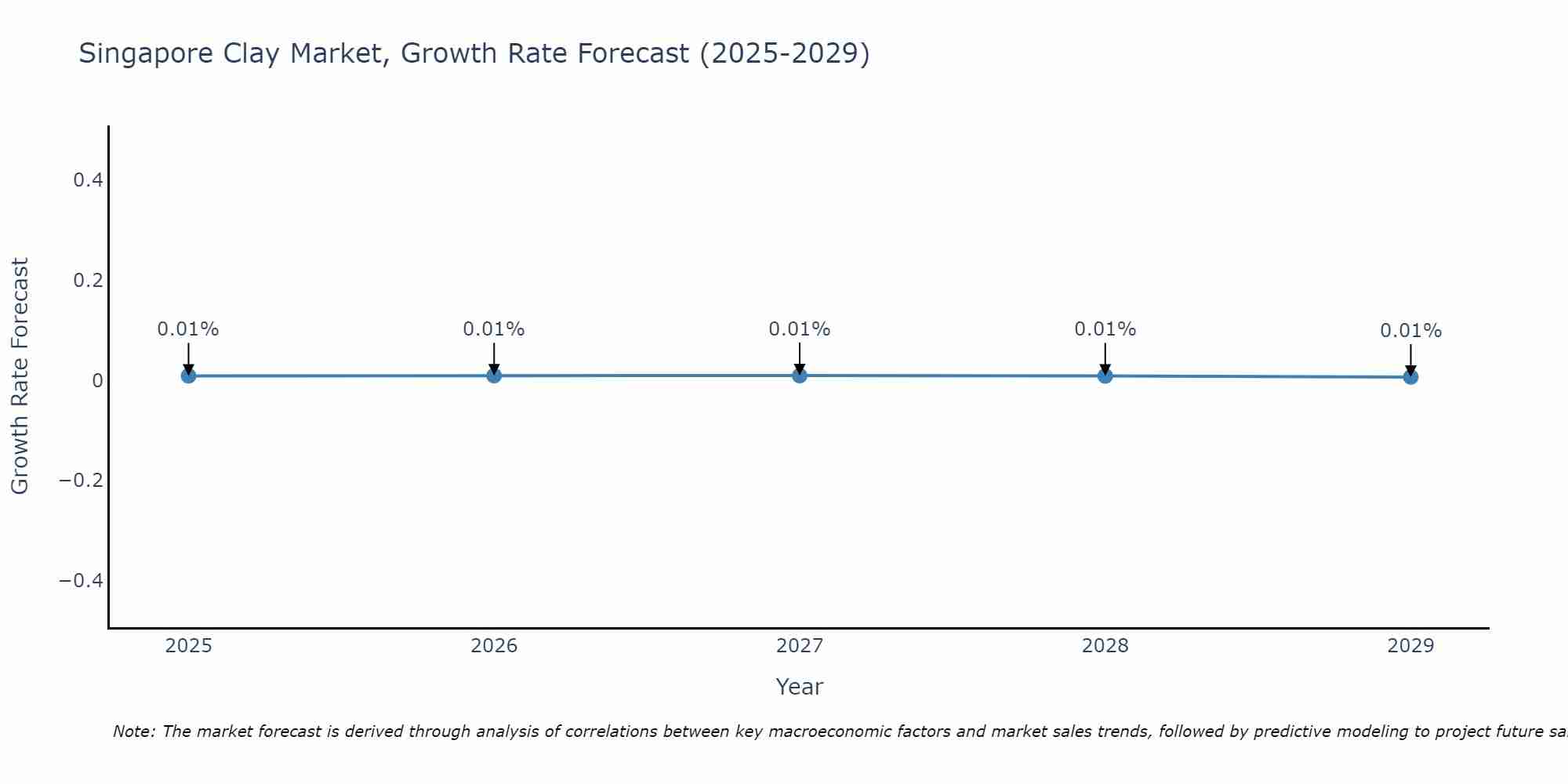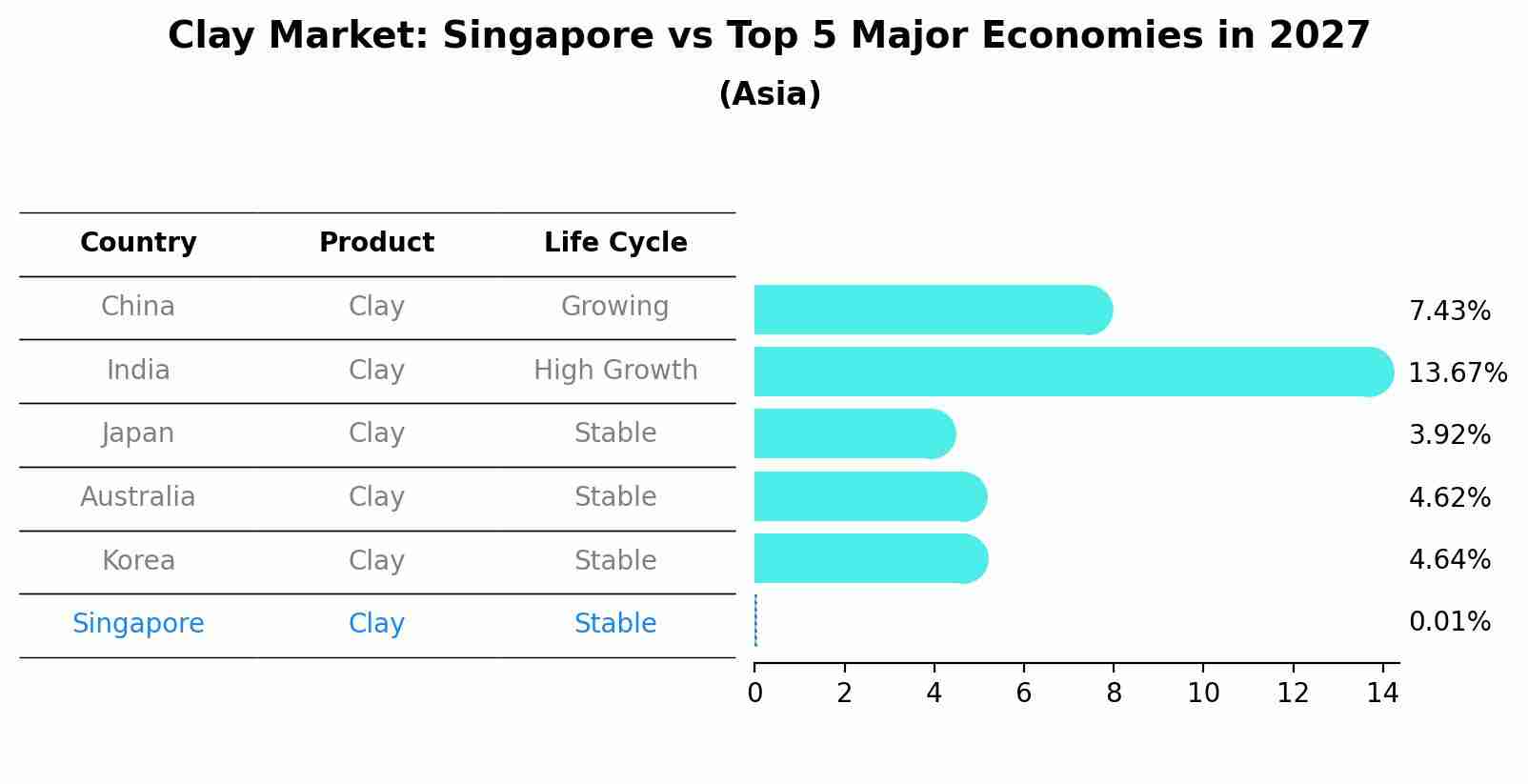Singapore Clay Market (2025-2031) Outlook | Share, Revenue, Forecast, Size, Trends, Industry, Value, Growth, Companies & Analysis
| Product Code: ETC318987 | Publication Date: Aug 2022 | Updated Date: Aug 2025 | Product Type: Market Research Report | |
| Publisher: 6Wresearch | No. of Pages: 75 | No. of Figures: 35 | No. of Tables: 20 | |
Singapore Clay Market Size Growth Rate
The Singapore Clay Market is projected to witness mixed growth rate patterns during 2025 to 2029. Growth accelerates to 0.01% in 2027, following an initial rate of 0.01%, before easing to 0.01% at the end of the period.

Clay Market: Singapore vs Top 5 Major Economies in 2027 (Asia)
By 2027, Singapore's Clay market is forecasted to achieve a stable growth rate of 0.01%, with China leading the Asia region, followed by India, Japan, Australia and South Korea.

Singapore Clay Market Synopsis
The Singapore clay market encompasses a range of applications, from construction to pottery and ceramics. Clay is a fundamental material used in the manufacturing of bricks, tiles, and ceramics, contributing significantly to the construction and art sectors. Singapore construction boom and growing interest in pottery and ceramics have driven the demand for clay products. The market`s growth is further supported by the country`s efficient logistics and supply chain networks, ensuring a steady flow of raw materials to meet the demands of various industries. Singapore commitment to sustainable building practices has also led to innovations in clay-based construction materials.
Drivers of the Market
The Singapore clay market is witnessing growth driven by the construction and pottery sectors. In construction, clay is used for making bricks, tiles, and other building materials. The thriving construction industry in Singapore, fueled by infrastructure development and urbanization, is a major driver for the clay market. Additionally, the growing interest in pottery as a hobby and art form is boosting the demand for clay among artists and enthusiasts. Moreover, the eco-friendly nature of clay as a sustainable building material aligns with the increasing environmental consciousness, further contributing to its market growth.
Challenges of the Market
The Singapore clay market encounters challenges related to environmental concerns and technological advancements. Clay extraction and processing can have adverse environmental impacts, including habitat disruption and soil degradation. Strict environmental regulations in Singapore require companies in this market to invest in sustainable practices, which may increase operational costs. Additionally, the market faces competition from alternative materials, such as polymers and composites, which offer advantages like lightweight properties and customization options. To remain competitive, clay manufacturers must innovate and adapt to changing customer preferences.
COVID-19 Impact on the Market
The COVID-19 pandemic had a multifaceted impact on the Singapore clay market. As construction activities slowed down and infrastructure projects were postponed, the demand for clay products in the building and construction sector declined. However, the pandemic also highlighted the importance of clay in manufacturing personal protective equipment (PPE), such as masks and gloves. Clay-based products like ceramics and pottery gained popularity as people turned to creative and artisanal hobbies during lockdowns. Additionally, the market saw increased demand for clay-based industrial products used in filtration, wastewater treatment, and pharmaceutical manufacturing. The pandemic underscored the versatility of clay across various industries, leading to a diverse set of challenges and opportunities for the market.
Key Players in the Market
In the Singapore clay market, companies like Imerys and Sibelco are significant players involved in the extraction and processing of clay minerals used in various industries, including ceramics, construction, and oil drilling.
Key Highlights of the Report:
- Singapore Clay Market Outlook
- Market Size of Singapore Clay Market, 2024
- Forecast of Singapore Clay Market, 2031
- Historical Data and Forecast of Singapore Clay Revenues & Volume for the Period 2021-2031
- Singapore Clay Market Trend Evolution
- Singapore Clay Market Drivers and Challenges
- Singapore Clay Price Trends
- Singapore Clay Porter's Five Forces
- Singapore Clay Industry Life Cycle
- Historical Data and Forecast of Singapore Clay Market Revenues & Volume By Application for the Period 2021-2031
- Historical Data and Forecast of Singapore Clay Market Revenues & Volume By Tableware for the Period 2021-2031
- Historical Data and Forecast of Singapore Clay Market Revenues & Volume By Sanitary ware for the Period 2021-2031
- Historical Data and Forecast of Singapore Clay Market Revenues & Volume By Medical applications for the Period 2021-2031
- Historical Data and Forecast of Singapore Clay Market Revenues & Volume By End Use for the Period 2021-2031
- Historical Data and Forecast of Singapore Clay Market Revenues & Volume By Ceramic and for the Period 2021-2031
- Historical Data and Forecast of Singapore Clay Market Revenues & Volume By Non-ceramic for the Period 2021-2031
- Singapore Clay Import Export Trade Statistics
- Market Opportunity Assessment By Application
- Market Opportunity Assessment By End Use
- Singapore Clay Top Companies Market Share
- Singapore Clay Competitive Benchmarking By Technical and Operational Parameters
- Singapore Clay Company Profiles
- Singapore Clay Key Strategic Recommendations
Frequently Asked Questions About the Market Study (FAQs):
1 Executive Summary |
2 Introduction |
2.1 Key Highlights of the Report |
2.2 Report Description |
2.3 Market Scope & Segmentation |
2.4 Research Methodology |
2.5 Assumptions |
3 Singapore Clay Market Overview |
3.1 Singapore Country Macro Economic Indicators |
3.2 Singapore Clay Market Revenues & Volume, 2021 & 2031F |
3.3 Singapore Clay Market - Industry Life Cycle |
3.4 Singapore Clay Market - Porter's Five Forces |
3.5 Singapore Clay Market Revenues & Volume Share, By Application, 2021 & 2031F |
3.6 Singapore Clay Market Revenues & Volume Share, By End Use, 2021 & 2031F |
4 Singapore Clay Market Dynamics |
4.1 Impact Analysis |
4.2 Market Drivers |
4.2.1 Growing popularity of DIY and craft activities |
4.2.2 Increasing focus on sustainable and eco-friendly products |
4.2.3 Rising demand for educational toys and materials |
4.2.4 Innovation in product design and packaging |
4.3 Market Restraints |
4.3.1 Competition from alternative art and craft materials |
4.3.2 Fluctuating raw material prices |
4.3.3 Limited availability of skilled artisans and craftsmen |
4.3.4 Challenges in distribution and logistics |
5 Singapore Clay Market Trends |
6 Singapore Clay Market, By Types |
6.1 Singapore Clay Market, By Application |
6.1.1 Overview and Analysis |
6.1.2 Singapore Clay Market Revenues & Volume, By Application, 2021-2031F |
6.1.3 Singapore Clay Market Revenues & Volume, By Tableware, 2021-2031F |
6.1.4 Singapore Clay Market Revenues & Volume, By Sanitary ware, 2021-2031F |
6.1.5 Singapore Clay Market Revenues & Volume, By Medical applications, 2021-2031F |
6.2 Singapore Clay Market, By End Use |
6.2.1 Overview and Analysis |
6.2.2 Singapore Clay Market Revenues & Volume, By Ceramic and, 2021-2031F |
6.2.3 Singapore Clay Market Revenues & Volume, By Non-ceramic, 2021-2031F |
7 Singapore Clay Market Import-Export Trade Statistics |
7.1 Singapore Clay Market Export to Major Countries |
7.2 Singapore Clay Market Imports from Major Countries |
8 Singapore Clay Market Key Performance Indicators |
8.1 Customer engagement on social media platforms |
8.2 Number of partnerships with educational institutions |
8.3 Percentage of revenue from new product launches |
8.4 Customer satisfaction scores from product quality surveys |
8.5 Rate of return customers and referrals |
9 Singapore Clay Market - Opportunity Assessment |
9.1 Singapore Clay Market Opportunity Assessment, By Application, 2021 & 2031F |
9.2 Singapore Clay Market Opportunity Assessment, By End Use, 2021 & 2031F |
10 Singapore Clay Market - Competitive Landscape |
10.1 Singapore Clay Market Revenue Share, By Companies, 2024 |
10.2 Singapore Clay Market Competitive Benchmarking, By Operating and Technical Parameters |
11 Company Profiles |
12 Recommendations |
13 Disclaimer |
- Single User License$ 1,995
- Department License$ 2,400
- Site License$ 3,120
- Global License$ 3,795
Search
Related Reports
- ASEAN and Thailand Brain Health Supplements Market (2025-2031) | Strategy, Consumer Insights, Analysis, Investment Trends, Opportunities, Growth, Size, Share, Industry, Revenue, Segments, Value, Segmentation, Supply, Forecast, Restraints, Outlook, Competition, Drivers, Trends, Demand, Pricing Analysis, Competitive, Strategic Insights, Companies, Challenges
- ASEAN Bearings Market (2025-2031) | Strategy, Consumer Insights, Analysis, Investment Trends, Opportunities, Growth, Size, Share, Industry, Revenue, Segments, Value, Segmentation, Supply, Forecast, Restraints, Outlook, Competition, Drivers, Trends, Demand, Pricing Analysis, Competitive, Strategic Insights, Companies, Challenges
- Europe Flooring Market (2025-2031) | Outlook, Share, Industry, Trends, Forecast, Companies, Revenue, Size, Analysis, Growth & Value
- Saudi Arabia Manlift Market (2025-2031) | Outlook, Size, Growth, Trends, Companies, Industry, Revenue, Value, Share, Forecast & Analysis
- Uganda Excavator, Crane, and Wheel Loaders Market (2025-2031) | Strategy, Consumer Insights, Analysis, Investment Trends, Opportunities, Growth, Size, Share, Industry, Revenue, Segments, Value, Segmentation, Supply, Forecast, Restraints, Outlook, Competition, Drivers, Trends, Demand, Pricing Analysis, Competitive, Strategic Insights, Companies, Challenges
- Rwanda Excavator, Crane, and Wheel Loaders Market (2025-2031) | Strategy, Consumer Insights, Analysis, Investment Trends, Opportunities, Growth, Size, Share, Industry, Revenue, Segments, Value, Segmentation, Supply, Forecast, Restraints, Outlook, Competition, Drivers, Trends, Demand, Pricing Analysis, Competitive, Strategic Insights, Companies, Challenges
- Kenya Excavator, Crane, and Wheel Loaders Market (2025-2031) | Strategy, Consumer Insights, Analysis, Investment Trends, Opportunities, Growth, Size, Share, Industry, Revenue, Segments, Value, Segmentation, Supply, Forecast, Restraints, Outlook, Competition, Drivers, Trends, Demand, Pricing Analysis, Competitive, Strategic Insights, Companies, Challenges
- Angola Excavator, Crane, and Wheel Loaders Market (2025-2031) | Strategy, Consumer Insights, Analysis, Investment Trends, Opportunities, Growth, Size, Share, Industry, Revenue, Segments, Value, Segmentation, Supply, Forecast, Restraints, Outlook, Competition, Drivers, Trends, Demand, Pricing Analysis, Competitive, Strategic Insights, Companies, Challenges
- Israel Intelligent Transport System Market (2025-2031) | Strategy, Consumer Insights, Analysis, Investment Trends, Opportunities, Growth, Size, Share, Industry, Revenue, Segments, Value, Segmentation, Supply, Forecast, Restraints, Outlook, Competition, Drivers, Trends, Demand, Pricing Analysis, Competitive, Strategic Insights, Companies, Challenges
- Uganda Precast and Aggregate Market (2025-2031) | Strategy, Consumer Insights, Analysis, Investment Trends, Opportunities, Growth, Size, Share, Industry, Revenue, Segments, Value, Segmentation, Supply, Forecast, Restraints, Outlook, Competition, Drivers, Trends, Demand, Pricing Analysis, Competitive, Strategic Insights, Companies, Challenges
Industry Events and Analyst Meet
Our Clients
Whitepaper
- Middle East & Africa Commercial Security Market Click here to view more.
- Middle East & Africa Fire Safety Systems & Equipment Market Click here to view more.
- GCC Drone Market Click here to view more.
- Middle East Lighting Fixture Market Click here to view more.
- GCC Physical & Perimeter Security Market Click here to view more.
6WResearch In News
- Doha a strategic location for EV manufacturing hub: IPA Qatar
- Demand for luxury TVs surging in the GCC, says Samsung
- Empowering Growth: The Thriving Journey of Bangladesh’s Cable Industry
- Demand for luxury TVs surging in the GCC, says Samsung
- Video call with a traditional healer? Once unthinkable, it’s now common in South Africa
- Intelligent Buildings To Smooth GCC’s Path To Net Zero













